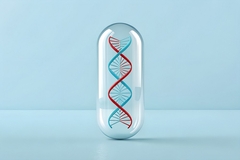Cellular arms race: Scientists find viruses, bacteria, and cells compete for iron levels in COVID-19 infections

New peer-reviewed research on COVID-19 suggests that the body is “ground zero for a cellular arms race.” With the human body’s mitochondria, red blood cells, and immune system relying on iron to function; so do invading viruses and bacteria.
As the body evolves safeguards for this critical resource, these safeguards select for invaders that can overcome them, scientists suggest.
“Iron is physiologically useful in catalyzing reactions, such as binding oxygen, because it both donates and accepts electrons,” explains US Binghamton University associate professor of Anthropology Katherine Wander, the first author of a recent paper on the topic.
“Iron nutrition and COVID-19 among Nigerian healthcare workers” is published in Evolution, Medicine, and Public Health.
War for iron
The body uses iron in various ways, from immune function to catalyzing reactions in mitochondria, which produce cellular energy in the form of adenosine triphosphate (ATP). Iron famously gives red blood cells their color. And red blood cells use a protein called hemoglobin to transport oxygen.
Hemoglobin, in turn, is made of smaller proteins known as heme, which contain an iron molecule that binds and transports the oxygen.
“Our pathogens need iron for the same reasons,” Wander explains. “A virus hijacks the cellular machinery to make more viruses. Often, viruses increase the cellular uptake of iron.”
Simply put, naturally high levels of iron offer needed resources for the body’s cells, but it also becomes available to pathogens, promoting their spread. “As a result, we have evolved layered, overlapping mechanisms to keep iron under control, while pathogens continually evolve ways to overcome these obstacles,” say the study authors.
In an evolutionary sense, the pathogens have the advantage, they stress.
COVID-19 represented an intriguing opportunity for their study, highlight the researchers. As a novel virus, it had less opportunity to adapt to human physiology — and “less time in the evolutionary arms race.”
Optimal “iron sweet spot”
The study focused on healthcare workers in four Nigerian hospitals working in coronavirus wards during the pandemic’s Delta wave. Most of them had Astra Zeneca vaccinations at this point, Wander notes.
“Even in the best of circumstances, our immune system can’t adapt as fast as something with a generation time of 20 minutes,” says Wander, referring to iron sequestration mechanisms.
“Bacteria and viruses are able to turn over new generations so quickly that their evolution just happens faster.”
In biological anthropology, the optimal iron hypothesis refers to a purported “sweet spot” that reduces susceptibility to infection, while mostly meeting the body’s iron needs.
The research in Nigeria revealed that individuals with plentiful iron in their system did have a higher risk of catching COVID-19, as well as people who had anemia, which can be caused by iron deficiency. But mild or moderate iron deficiency, however, didn’t seem to protect against infection in and of itself.
The case study of COVID-19 suggests that even very early in the arms race — when an infectious disease is emerging and still very new to humans — iron nutrition tradeoffs are in play.
“Any additional increment of iron is going to come with both potential benefits in terms of immune defense and potential risk from an infectious agent,” says Wander. “The trade-off is always there, but the optimal level is going to shift depending on the infectious disease environment.”
This tradeoff is potentially one of the reasons why iron deficiency is common even in otherwise well-nourished populations, particularly among women.
The body tends to conserve iron, recouping 80% of the iron contained in senescent blood cells. However, the human body is not particularly efficient at absorbing iron, and dietary factors can interfere with this process.
“Humans seem to be vulnerable to iron deficiency, and we try to solve that problem by helping people improve their iron intake and iron absorption,” says Wander. “It’s hard to do.”
Broadening iron’s applicability
In other iron supplementation research, independent medical researcher Cochrane suggests that iron supplements taken during and beyond pregnancy offer broader women’s health claims. This includes reductions of maternal anemia and positive effects on infant birth weight.
At Vitafoods 2024, gummy supplement manufacturer TopGum launched IronGum — high-dose iron gummies with a sensory appeal, specially formulated to eliminate the typical metal-like taste.
Tackling bioavailability, Lubrizol Life Science offers a microencapsulation technology that helps enhance iron absorption and reduces gastric irritation and other side effects of iron supplements, such as an off-taste or interaction with other ingredients.












